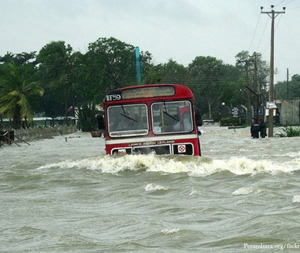Ilankai Tamil Sangam30th Year on the Web Association of Tamils of Sri Lanka in the USA |
|||
 Home Home Archives Archives |
Why is it Perplexing?by Tamil Guardian, London, March 30, 2011
Two months after what has been described as Sri Lanka’s worst natural disaster since the 2004 tsunami, the lives of those in the most affected districts of Batticoloa, Amparai and Trincomalee remain devastated. The state’s much hyped rhetoric of aid has not materialized into tangible relief. Quite the reverse. In a predictable repeat of the post-tsunami situation, the state’s efforts to hamper flood relief for Tamil areas are part of a wider determination to block re-development there.
Meanwhile, those involved in humanitarian support for Tamil civilians have long been subject by the state to intimidation, harassment, abduction and even murder - crimes that continue with impunity. Nearly six years since seventeen Action contre la Faim (ACF) workers were murdered in Trincomalee, not only has no one been punished, the state’s intimidation of humanitarians is unabated. Recent reports of attacks on Batticaloa village officers by the state’s paramilitary allies, and the abduction of three Christian priests in Batticaloa who were providing flood relief, are met with customary nonchalance by the state. Despite proclaiming the end of war and the emergence of ‘peace’, a climate of sovereign menace prevails in the Tamil areas. Just this month, several international NGOs, including the American agency, Care International, stated their intentions to wind down operations in Sri Lanka, a move linked directly to the restrictions placed on NGOs, including new visa regulations and government interference in the distribution of aid. Alongside directed intimidation of some, the reputation of NGOs collectively are attacked amid a popular Sinhala nationalist hostility towards foreigner actors – still denounced as ‘pro-LTTE’ or ‘pro-separatist.’ In the floods’ aftermath, as with the ongoing post-tsunami and post-conflict humanitarian crisis, the state’s standard policy vis-à-vis Tamil suffering is clear: the diversion of international aid alongside violent intimidation of those involved in providing relief. This habitual response to Tamil suffering, and the underlying Sinhala-Buddhist extremism from which it stems, are recognised by all close observers of Sri Lanka's protracted crisis: when its for the Tamils, humanitarian relief, development and equitable growth are seen to constitute a direct threat to a Sinhala-first order. Yet, the international community continues to remain ‘perplexed’. Even amid the slaughter of the closing stages of the war, as US embassy cables reveal, Western officials were certain that Sri Lanka would welcome international assistance towards rehabilitation as soon as the fighting ended. They were wrong. Sooner or later, Sri Lanka will end up on the international agenda. But much more suffering - and strife - will have to take place between now and then. |
||
|
|||
 Since the first wave of the recent floods, there have been reports of direct or subversive state attempts to undermine the relief effort in the East: of government officials
Since the first wave of the recent floods, there have been reports of direct or subversive state attempts to undermine the relief effort in the East: of government officials